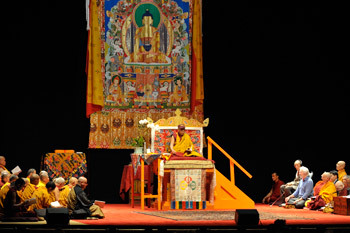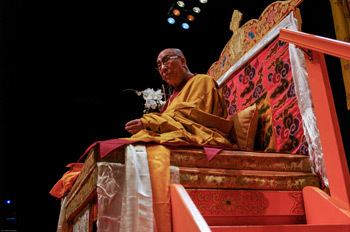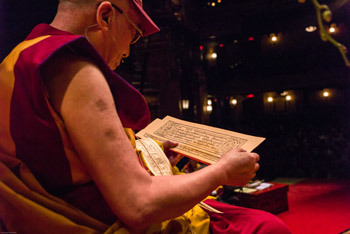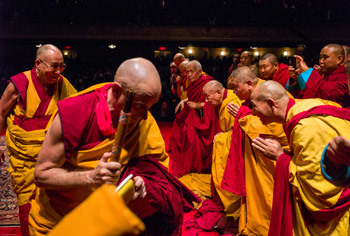New York, USA, 18 October 2013 - His Holiness the Dalai Lama flew into Newark from Mexico yesterday afternoon and was received on behalf of his hosts, The Tibet Center and The Gere Foundation, by Khyongla Rato Rinpoche, Rato Khenpo Nicholas Vreeland and Richard Gere, who escorted him into New York. Excited Tibetans thronged the streets around his hotel, while musicians and dancers celebrated his arrival and he was offered a traditional Tibetan welcome.
This morning, as he made his way to the Beacon Theater, where he was to speak to nearly 3000 people, a group of elderly Tibetans waited to pay their respects to him, presenting their rosaries and amulets for blessing, their eyes moist with devotion. As he walked onto the stage, His Holiness greeted many old friends amongst the Sangha gathered around the throne and saluted the audience with folded hands. Richard Gere made a brief introduction as His Holiness took his seat on the throne. He announced that first the Mangala Sutta would be recited by monks in Pali, followed by a recitation of the Heart Sutra in Sanskrit and that he would then recite laudatory verses in Tibetan that convey the essence of the Buddha’s teaching.
“Good morning everybody,” he began. “Once again we have the opportunity to gather together as many of us have done previously. How many of you have listened to an explanation of the Heart Sutra before? Raise your hands. So, since our previous meeting, how much progress have you made? The purpose of giving teachings like this is for us to be able to transform our minds, our emotions; not to become holier, but to become happier and ultimately to become a Buddha.”
He related the words of the mantra from the Heart Sutra ‘Go, go, go beyond, go perfectly beyond, enlightened so be it’ to the paths of accumulation, preparation, insight, meditation and no more learning or the attainment of enlightenment. He quoted the Buddha as saying that every sentient being with consciousness possesses the essence of Buddhahood. If that seed is nurtured it will grow, but you have to make the effort. That is the main purpose of a discussion or teaching like this.
His Holiness declared that he has great respect for other religious traditions and wherever he can he makes an effort to cultivate inter-religious harmony. He added that when he talks about Buddhism in non-Buddhist countries he always advises his listeners to stick to the faith of their birth, noting that friends in the past who changed their faith had sometimes ended up confused.
“In India there are people who complain about an invasion of American culture. Please don’t think of my visit as an Asian invasion of America. It’s a mutual exchange. Some of my Christian monastic brothers and sisters have adopted Buddhist practices and for 50 years I have encouraged our Buddhist monks and nuns to follow the Christian example of social engagement, particularly in the fields of education and health. I have also commended the simplicity of many Christian practitioners’ way of life.

|
| View of the stage at the Beacon Theater, venue for His Holiness the Dalai Lama's teachings in New York City, NY, USA on October 18, 2013. Photo/Sonam Zoksang |
“Now, Khyongla Rato Rinpoche and I are both students of the late Kyabje Ling Rinpoche. He is the senior student, but I, the younger one, have the name Dalai Lama. I have a close bond with him and with Richard Gere who is a friend of mine and a friend of Tibet. They asked me to give this teaching. For many years Rinpoche has requested me to give the oral transmission of the Perfection of Wisdom Sutra in 8000 lines. As we drove in from the airport yesterday he mentioned it again and I thought, “Let’s start now.” The book is about 500 pages long, so looking at it I feel somewhat daunted, but I won’t try to read it all now, I’ll just begin today.”
He explained that the Perfection of Wisdom Sutras form a large part of the Buddhist scriptures. Of those sections translated into Tibetan, the longest is in 100,000 lines and consists of 12 volumes, the version in 25,000 lines is in 3 volumes, this edition in 8000 lines is only one volume, while the shortest sutra consists of the syllable ‘A’.
‘A’ denotes a negation, ‘not’ in the context that while everything appears to exist independently, it does ‘not’. Existing due to other factors things are actually interdependent. However, the appearance of independence is the basis of disturbing emotions like attachment that ultimately brings us problems.
In connection with the ‘8000 lines’ His Holiness had a story to tell:
“At 10pm Lhasa time on 17th March 1959 I left the Norbulingka. Shortly beforehand, at 9.30, I read a few pages of this text, so it retains a special significance for me.
“I received the oral transmission from Tsenshab Serkong Rinpoche and I gave it in Drepung about 30 years ago at a time when great masters like Gyen Pema Gyaltsen and Gyen Nyima were there. It’s a text regarded with special reverence in the Tibetan tradition. Dromtonpa regarded it with special respect and I have followed his custom of having it recited when embarking on new projects like starting a building.”
With that introduction His Holiness began his recitation, soon reaching the reference to the one member of the assembly around the Buddha who had not achieved the liberation of an Arhat - Ananda. Perhaps being a relative of the Buddha he had an element of pride that obstructed his realization, which later led to his being rebuked.

|
His Holiness the Dalai Lama speaking during the first day of his three day teaching in New York City, NY, USA on October 18, 2013. Photo/Robert Nickelsberg
|
His Holiness reiterated advice he has been giving Tibetans to regard the 300 volumes of the Tibetan Buddhist Canon, of which this text is one, not so much as objects of reverence, but as textbooks, objects of study. He repeated that the real practice of the Dharma is the transformation of our emotions.
Resuming his teachings after lunch, he began to explain the ‘The Sutra of Truly Remembering the Sublime Three Jewels’, which he received as part of the Drepung Liturgical Collection from Tagdrag Rinpoche. The text is a form of salutation, reflecting on the qualities of the Three Jewels. The conventional order is to refer to the appearance of the Buddha and his explaining the Dharma, which concerns cessation and realization of the nature of truth. Those who experience such realization become Sangha. However, in terms of the individual, the Dharma comes first as realization, leading him or her to become Sangha. And through prolonged cultivation of realization he or she becomes a Buddha.
His Holiness stressed that what is important is having an attitude of deep dedication to the awakening mind of bodhichitta. He remarked that those who consider the bodhisattva’s career over three countless aeons too long and turn to the practice of tantra intent on enlightenment in 12 or 3 years reveal a degree of self-centredness. He told a story about how when Atisha was in Tibet he liked to keep up with what was happening in India. He was apparently shocked to hear about a Hevajra practitioner who achieved a calmly abiding mind, but was reported to have attained the status of stream-enterer, the first path towards becoming an Arhat, because he had not developed the awakening mind.
If we ask by what reason we understand that the achievement of the Three Jewels is possible, it is because we have Buddha nature. He added that what makes the Buddhist practice of the three trainings - ethics, meditation and wisdom - unique is the explanation of selflessness. This understanding or wisdom is derived from study and learning followed by critical, sceptical reflection and completed in meditative experience. Nevertheless, such meaningful analysis has then to be translated into day to day life. The Buddha’s intent was that his teachings be implemented.

|
His Holiness the Dalai Lama reading from a Tibetan text during his teachings at the Beacon Theater in New York City, NY, USA on October 18, 2013. Photo/Robert Nickelsberg
|
In this connection, His Holiness commented that the distinction between Mahayana and Hinayana or the greater and lesser vehicles should not be seen in terms of hierarchy, but in terms of the extent of their scope. The practices of the Pali tradition are fundamental to Mahayana practice. The Mahayana is not an alternative, but adds to the fundamental vehicle. Similarly, followers of Tantrayana add to the practice of the Mahayana.
In his account of the Heart Sutra, His Holiness explained that the words ‘form is emptiness, emptiness is form; form is not other than emptiness... ’ and so on refer to the Two Truths. Conventional and ultimate truth are not different entities, they refer to different perspectives. Emptiness does not refute the existence of phenomena so much as the way they are perceived. It is the fantasy, the exaggeration of the qualities of the object, whether we are attached or averse to it, that is refuted. This resonates with conversation His Holiness had with the American psychiatrist Aaron Beck who told him that of our feelings of attachment or aversion to something about 90% is our projection.
With abundant energy His Holiness taught significantly beyond the announced time today. He will resume his teaching tomorrow morning.
















